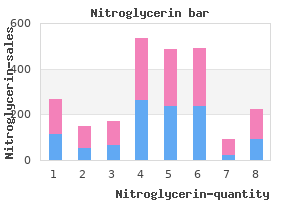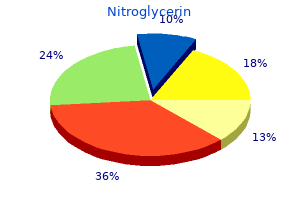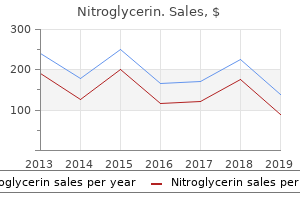

"Discount nitroglycerin american express, medicine keri hilson lyrics".
By: X. Treslott, M.B. B.CH. B.A.O., Ph.D.
Clinical Director, University of North Texas Health Science Center Texas College of Osteopathic Medicine
When spilled onto the skin medicine valley high school purchase nitroglycerin amex, the tar cools comparatively quickly treatment tracker order nitroglycerin 6.5 mg with mastercard, but the retained warmth is adequate to produce a partialthickness burn treatment synonym purchase cheapest nitroglycerin and nitroglycerin. Agents similar to alcohol, acetone, kerosene, or gasoline have been used to take away the tar, however these are flammable and will trigger further pores and skin damage or a poisonous response secondary to absorption. Obviously devitalized skin can be d�brided, however adherent tar must be emulsified or dissolved somewhat than manually eliminated. Note that the cream formulations, not the ointments, comprise essentially the most useful tar dissolvers. The creams contain a fancy combination of ethers, esters, and sorbitol anhydrides that possess glorious hydrophilic and lyophilic characteristics when used as nonionic, surface-active emulsifying brokers. With persistence, most tar may be removed (emulsified) on the initial visit, although this can be unnecessary as beforehand detailed. Physical removing of cooled tar usually leads to avulsion of the underlying skin. Neomycin cream, not ointment, is a advised emulsifier, however others are acceptable (see text). Frequent dressing adjustments and utility of an emulsifying agent may be carried out by the affected person to take away the tar over a interval of a few days. B, this extremity was covered with an emulsifying agent and with gauze, and the residual tar was washed off simply 36 hours later. Because De-Solv-It is itself a petroleum-based solvent, it must be applied solely briefly, and the operator should put on gloves and protective eyewear during utility. Many clinicians instead choose to emulsify nearly all of tar on an outpatient foundation. A generous layer of polysorbate-based ointment can be applied underneath a cumbersome absorbent gauze dressing. The patient is then launched home, and the residual tar is easily washed off after 24 to 36 hours. Flushing serves to cleanse the wound of unreacted floor chemical, dilute the chemical already in contact with tissue, and restore lost tissue water. Leonard and colleagues63 clearly demonstrated that sufferers receiving quick copious water irrigation for chemical burns had less full-thickness burn harm and a 50% or higher reduction in hospital stay. Flushing should be thorough and will require at least 30 minutes (or as much as 2 hours) for maximal benefit, depending on the nature of the chemical. Acid and Alkali Burns Chemical burns trigger progressive tissue damage until the chemical is inactivated or removed. Acids damage tissue by coagulation necrosis, a process that limits the depth of penetration into tissue. Skin uncovered to caustic substances must be decontaminated aggressively till neutralized and the resulting wounds thought-about deep until demonstrated otherwise. Desiccant acids, such as sulfuric acid, create an exothermic response with tissue water and can trigger both chemical and thermal injury. With intensive immersion injuries, acids could additionally be absorbed systemically, thereby leading to systemic acidosis and coagulation abnormalities. Discomfort can be out of proportion to what one would possibly anticipate from the perceived depth or extent of the burn. When caring for a chemical burn, the emergency care group should remove all probably contaminated clothes. The concerned pores and skin ought to then be irrigated with massive amounts of water beneath low strain. Chemical Burns Chemical burns typically occur within the office, and the offending substance is normally well-known. More than 25,000 chemicals presently in use are capable of burning the skin or mucous membranes. Commonly used chemical brokers capable of producing pores and skin burns are proven in Box 38. The injury to pores and skin continues till the chemical agent is physically eliminated or exhausts its inherent damaging capability. The degree of damage is based on the power, focus, and amount of the chemical; length of contact; location of contact; extent of tissue penetration; and mechanism of motion.

Common causes of tenosynovitis embrace trauma treatment uveitis discount nitroglycerin online, diabetes mellitus 911 treatment buy nitroglycerin on line amex, and rheumatoid arthritis symptoms 8 days before period purchase discount nitroglycerin online, though it may even be a main and idiopathic dysfunction. One double-blind, placebo-controlled, randomized study of set off finger demonstrated that steroid injections had been significantly more effective than placebo. Similar results had been famous in a 2009 Cochrane evaluation, which found that corticosteroid injection with lidocaine was more practical than lidocaine alone at four months. If resistance is felt on insertion of the needle, an intratendinous location is recommended. Similar injections may be administered in the base of the thumb metacarpal for a snapping thumb. Although injection into the tendon sheath is the aim, Taras and coworkers127 showed that injection of steroid into the subcutaneous tissue surrounding the tendon sheath offered similar improvement as intrasheath injections. Palpation of the flexor tendon sheath over the metacarpophalangeal joint typically reproduces the symptoms. In advanced circumstances, irritation at the proximal (A1) pulley of the flexor tendon sheath overlying the metacarpophalangeal joint could hold the digit in both a flexed or an prolonged position. Generally, the tendon becomes thickened either proximal or distal to the pulley, which causes a snapping or a locking phenomenon with finger flexion or extension. Nodule A2 pulley Flexor tendon A1 pulley Metacarpal head Locate the tendon level on the base of the finger flexion crease, which is situated between the A1 and A2 pulleys. Angle the needle 30 levels into the concerned tendon sheath, parallel to the tendon fibers. The first metacarpal articulates with the trapezium, a typical website for this condition. The principal bursae, when involved, are the subgluteus maximus bursa, the subgluteus minimus bursa, and the gluteus minimus bursa, though different bursae of the hip may be affected. The chief locus of the pathologic situation is in the abductor mechanism of the hip. Pain occurs near the higher trochanter and may radiate down the lateral or posterolateral side of the thigh and, not often, into the knee. Gluteus medius Gluteus minimus Subgluteus medius bursa Greater trochanter Subgluteus maximus bursa Fascia lata Femur injection of betamethasone combined with lidocaine; 61% of the patients had sustained enchancment at 26 weeks. Place the affected person in a supine or lateral recumbent place and determine the location of most tenderness for needle entry. Withdraw the needle slightly and extensively infiltrate the site with 3 to 10 ml of lidocaine and 20 to 40 mg of methylprednisolone or an equivalent steroid. The principal bursa lies between the gluteus maximus and the greater trochanter, although other bursae may be concerned. Active abduction when the affected person lies on the opposite aspect sometimes intensifies the discomfort, and sharp external rotation may intensify the signs. The ischial or ischiogluteal bursa is adjacent to the ischial tuberosity and overlies the sciatic and posterior femoral cutaneous nerves. Patients are often asymptomatic when standing; nevertheless when going to a seated place, the gluteus maximus muscle slides away from the bursa allowing for direct contact between the bursa and subcutaneous tissue. The situation is commonly associated with a sedentary way of life, which is the place it gets its nickname. Sitting on exhausting surfaces, bending forward, and standing on tiptoes might all provoke the pain. Insert After the trochanter is reached, withdraw the needle barely, and the needle at the area of most tenderness, and advance infiltrate the positioning broadly with three to 10 mL of lidocaine and 20 to forty perpendicular to the skin until the needle tip reaches the larger mg of methylprednisolone (or the equivalent). Advance the needle cautiously to avoid the sciatic nerve, which lies at a depth of approximately 6. If paresthesias occur (indicating contact with a nerve), withdraw and redirect the needle. Inject 5 to 10 ml of lidocaine and 20 to 40 mg of methylprednisolone into the bursa. Because of the shut proximity of the bursa to the sciatic nerve, some specialists advise against the use of injection remedy in this area, especially as the addition of steroids can cause soft tissue atrophy making sitting uncomfortable. Patella Prepatellar bursa Deep infrapatellar bursa Superficial infrapatellar bursa Tibia Sartorius Gracilis Semitendinosus Anserine bursa Prepatellar Bursitis. In distinction to intraarticular pathology, passive motion of the knee is totally preserved and the ache is usually mild, besides throughout extreme knee flexion or direct pressure. Acute bursitis is extra more doubtless to be septic with the commonest micro organism being pores and skin flora; nevertheless, gout and direct trauma are also identified causes.

A treatment zinc deficiency order nitroglycerin toronto, An expeditious and comparatively painless method to symptoms schizophrenia buy 6.5 mg nitroglycerin with amex d�bride a burn is to use a dry gauze pad to grasp the dead skin and B medicine 6 clinic order nitroglycerin with a visa, peel it off. Meticulous instrument d�bridement is commonly time-consuming and tense to the affected person. Be conscious that pain happens when air is out there in contact with the d�brided skin, and prophylactic analgesia ought to subsequently be offered. It could also be tough to separate the erythema of the harm or therapeutic course of from cellulitis, however minor burns rarely become contaminated, with infection rates being well beneath 5%. Because thermal trauma results in coagulative necrosis, burn wounds include a variable amount of necrotic tissue which, if infected, acts a lot as an undrained abscess and prevents entry of antibiotics and host protection components. Shortly after injury, the burn becomes colonized with gram-positive micro organism such as S. A therapeutic burn might produce leukocytosis and a mild fever within the absence of infection, especially in youngsters. Early (days 1 to 5) burn infections are generally brought on by gram-positive cocci, particularly -hemolytic streptococci. Streptococcal cellulitis is characterized by marked spreading erythema extending outward from the wound margins. Despite the plethora of organisms and the presence of some gram-negative pathogens in superficial burn cultures, normal gram-positive cellulitis protection is appropriate preliminary remedy in most cases. Effective topical therapy on the time of preliminary burn care and subsequent dressing changes is meant to delay bacterial colonization, maintain the bacterial density of wounds at low ranges, and produce a less various wound flora. Because outpatient administration of burns should be attempted only when the danger for infection is minimal, using systemic antibiotics is unnecessary for minor burns, even in the setting of delayed treatment, diabetes, and steroid use. Antibiotics within the management of minor burns have been really helpful for patients present process an autograft process. It is useless, for example, to culture blister fluid in a patient who arrives for emergency care instantly after a thermal harm. Cultures are essential solely when overt infection develops, particularly when it occurs when a topical or systemic antibiotic is being used. Cultures may be of benefit when the infected wound is old, when hygiene is poor, or when there are preexisting abrasions close by. Sterile wound biopsy for culture is most satisfactory for the assessment of intraescharotic, subescharotic, or invasive infections and allows quantification of bacterial flora. It is troublesome for many patients to provide perfect burn care at residence when the ft are concerned. Unless home health care, a wound care heart, or different comparable preparations can be found to the patient, hospitalization could also be most prudent until these preparations could be solidified. B, Example of a foot burn that could be a potential disaster, on this case due to late remedy of a diabetic patient. Foot burns are the most common burn category to fail outpatient remedy, and subsequently require admission and inpatient care. In no affected person admitted on the day of harm did burn cellulitis develop; in contrast, 27% of delayedadmission sufferers had cellulitis. Their study also noted a higher incidence of hypertrophic scarring with the necessity for pores and skin grafting in the delayed-admission group. Overall, fewer days of hospitalization had been required for the initially admitted group. Specific issues in the care of foot burns embody pain, wound drainage, issue altering dressings without help, incapability of even motivated patients to comply with the requirements for elevation, and extended convalescence. The benefits of hospital admission include splinting, intensive native burn care, physical therapy, and mattress relaxation with elevation, which minimizes edema. For these causes, initial admission should be considered for all however the most minor of foot burns. Close outpatient follow-up wound checks are required for these foot burns that are most applicable for outpatient care. Deep partial- or full-thickness hand burns, even if quite small, often warrant referral for early excision and grafting to restrict scarring and preserve perform. The skin on the dorsum of the hand is thinner than that on the palm and is more prone to burn harm so it must remain flexible to permit finger motion. Any exposed tendon or bone, such as may be seen with an electrical burn, constitutes a real fourth-degree injury, and either flap closure or amputation is required to heal the wound.

Syndromes
Perform paracentesis in accordance with treatment math definition proven 6.5 mg nitroglycerin compliance with standards for physique fluid precautions medications blood thinners purchase nitroglycerin 2.5 mg without a prescription. Observe sterile approach throughout the procedure to forestall the iatrogenic introduction of micro organism into the stomach wall tract or peritoneal cavity treatment impetigo buy 2.5 mg nitroglycerin with visa. Theoretically, most websites on the stomach wall can be utilized, but in absence of earlier expertise with the individual patient, two websites are preferred. If the patient has midline scarring or if earlier experience has been constructive, the preferred alternative web site is in either the best or left lower quadrant, approximately 4 to 5 cm cephalad and medial to the anterior superior iliac backbone. The importance of remaining lateral to the rectus sheath is to avoid the inferior epigastric artery. Patients with a big quantity of ascites can readily undergo the procedure in the supine place with the top of the mattress slightly elevated. In this example the midline is aspirated, although lateral rectus sites can also be used. Some choose the lateral decubitus position routinely because the bowel tends to float upward and out of the trail of the needle. The patient had imprecise abdominal pain only, a refined manifestation of a serious problem. Some clinicians favor to use the lateral decubitus place routinely as a outcome of the bowel tends to float upward and away from the path of the needle. Hence, the positioning of needle entrance is within the midline or on the facet closest to the mattress. Following sterile preparation of the pores and skin, inject native anesthetic on the paracentesis site. Advance the catheter over the needle and into the peritoneal cavity (if a catheterover-the-needle system is being used). For this method, pull the skin approximately 2 cm caudad to the deep stomach wall with the non�needlebearing hand whereas slowly inserting the paracentesis needle. Remove the needle after the procedure, and the skin will slide to its unique place, helping seal the tract. In any case, insert the needle slowly in 5-mm increments to detect undesired entry of a vessel and to assist prevent unnecessary puncture of the small bowel. Avoid steady suction because it could appeal to bowel or omentum to the end of the paracentesis needle with resultant occlusion. If circulate ceases, gently rotate the needle and advance it inward in 1- to 2-mm increments. When fluid removing is complete, take away the needle and place an adhesive bandage over the puncture site. First place the patient so the location is in a non-dependent position and apply stress to the site with gauze for ten minutes. Dry air utilized to the adhesive using nasal cannula can enhance drying of the adhesive. This approach clearly delineates the pocket of ascitic fluid and permits visualization of loculated collections and avoidance of bowel adherent to the anterior stomach peritoneum. The ultrasonographer scans the stomach and marks the skin at the level overlying the optimum puncture web site. Pull the skin approximately 2 cm caudad in relation to the deep abdominal wall with the non�needle-bearing hand whereas slowly inserting the paracentesis needle perpendicular to the pores and skin. B, After penetrating the peritoneum and acquiring return of fluid, launch the pores and skin. C and D, Use of the Z-tract method helps seal the tract and forestall persistent fluid leaks. Removal of 5 or 6 L is routine and properly tolerated, and for therapeutic functions, at least this quantity ought to be removed. Hence, their ascites is prone to be far more voluminous than in these treated frequently. In basic, the paracentesis volume consists of as a lot fluid as may be removed without extreme manipulation of the patient. For first-time paracentesis and for diagnostic functions (ruling out bacterial peritonitis, screening for cancer), 200 to 500 mL is usually sufficient, however more can be drained if it flows simply.
Buy generic nitroglycerin 2.5 mg. Signs of Depression|Depression in Urdu/hindi|ڈیپریشن کی وجوہات|.